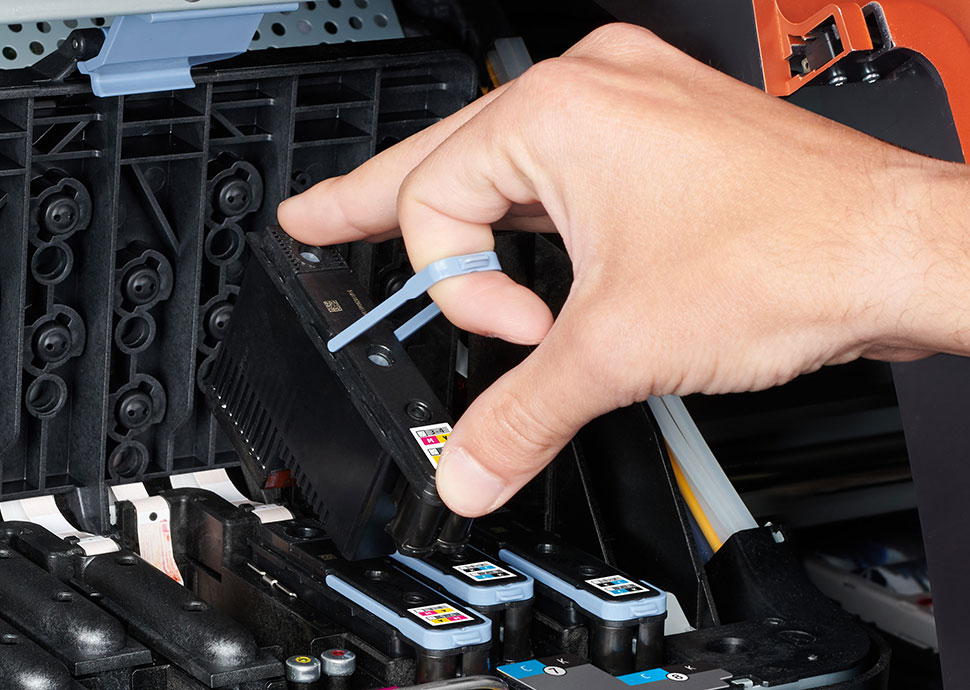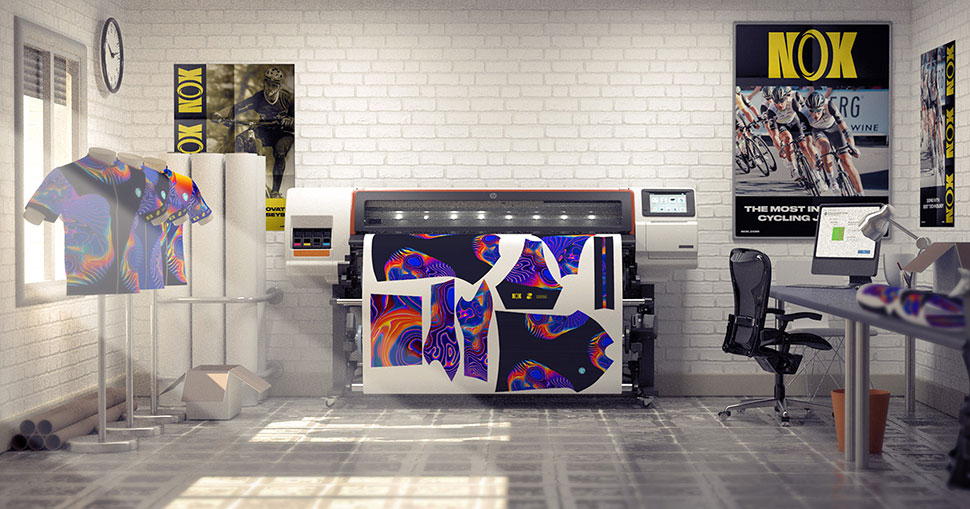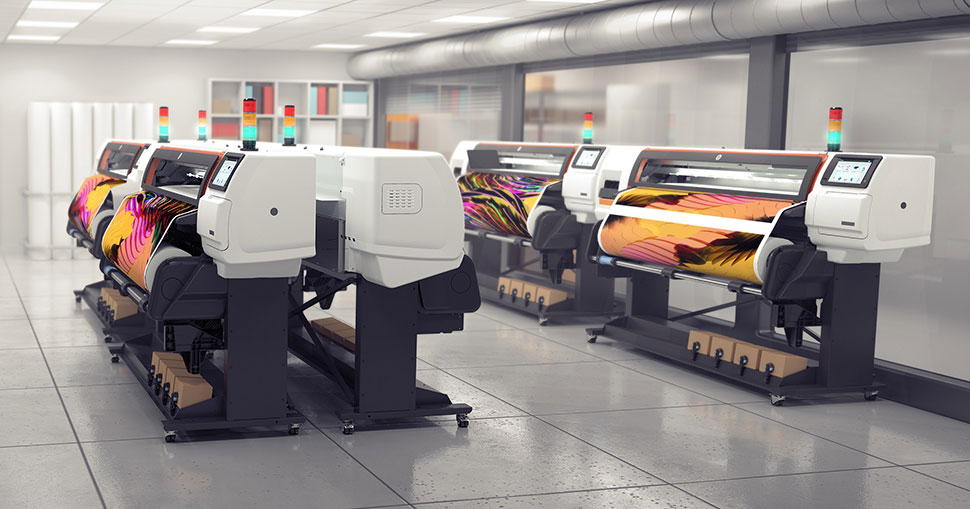Having supplied textile printing solutions for some 40 odd years and serving as a UK partner for a list of hardware, software, ink and materials suppliers that reads like a veritable ‘who´s who’ of textile printing, we couldn’t really think of anyone better than the team at RA Smart to help us take a more in-depth look at the technicalities of the HP Stitch dye-sublimation printer.
Firstly, full disclosure: RA Smart does sell HP Stitch printers. However, they also work closely with enough competing brands to make them uniquely equipped to advise impartially on the best solution for any number of specific textile printing requirements. It also leaves us completely comfortable that the information provided will be balanced and well-reasoned.
We spoke with Alex Mighall at RA Smart to dive deeper into the world of HP Stitch printing technology.
Q: Can we start with your overview of the HP Stitch, and what it is that makes it different?
A: Well, the first key thing is the printhead technology. The perceived wisdom has long been that piezo printheads were the only viable option for sublimation printing, primarily because the heat created in a thermal print head made it ‘impossible’ for them to jet sublimation inks. However, with the HP Stitch we’re seeing innovation and ingenuity that rewrites those rules and HP has delivered a thermal inkjet textile printer that offers some unique features and functions.
The printhead is very much the engine of a printer, responsible for delivering the speed, the quality and ultimately the reliability of the overall print solution.
A significant benefit is in the number of nozzles in an HP Stitch printhead versus competing piezo inkjet printers. HP Stitch thermal printheads feature 1200 nozzles per inch, where a piezo printer will typically have between 100 to 300 nozzles per inch. More nozzles equate to more ink laid down in less time and with fewer passes, and that directly affects speed. Thermal print heads can print up to 64 droplets of ink in the same space that a piezo printer places just one – and that is done in one pass. Ultimately this all contributes to the HP Stitch device printing fast without having to sacrifice quality and delivering superior productivity.
Q: How about the fact that the HP Stitch has these printheads as a replaceable consumable, rather than the longer life permanent piezo printhead. Does that not lead to higher running costs?
A: Well of course we hear this all the time because it’s one of those things that salespeople will often say when selling against the Stitch. The reality is actually a little different, and there are pros and cons to both printhead types.
So yes, the HP Stitch printheads are a consumable item, but we are typically seeing individual heads lasting for 10 to 12 litres of ink in the field. For some printers in lower volume settings – perhaps a university, for example – that volume of ink might see them through an entire year, so it´s not the ‘constantly changing the heads’ scenario that some will portray.
Also, the cost of an HP Stitch printhead runs at about 10% – or less – of that of a piezo printhead and can be changed by the operator on the fly. So, it´s important to note that whilst a piezo head will last longer, it isn´t user changeable like the HP Stitch, and it will absolutely require an engineer visit for replacement.
Further, with a piezo printer you will not get the quality on day 365 that you got on day 1; nozzles will get blocked, and the quality degrades over time in a linear way. Compare that to the HP Stitch, where the quality is actually reset back to 100% every time you change a printhead and maintained throughout its life.
In our experience so far, based on us monitoring printers in the field, there is no significant price penalty to pay for the HP Stitch having consumable printheads, and in many cases – and certainly in terms of maintaining quality – the regular printhead changes can be beneficial.

Q: What else are you finding is key about the HP Stitch in the field?
A: They’re the world’s first dye sublimation printer with a built-in colour spectrophotometer, revolutionising colour management for our customers. It allows them to create a unique colour reference for each print job and store it in the HP cloud. These references can then be deployed whenever, or wherever, the customer wishes. That could be a repeat job in 5 years’ time or to match a partner’s printer, anywhere else in the world! It´s an incredible feature and one that our customers value greatly.
Other key features include the internal drying and the media tensioning. Both contribute significantly to eliminating cockling on even lightweight papers. This gives users greater media choice and reduces reliance on premium high-cost media, which ultimately reduces running costs.
Q: What sort of printing are you seeing HP Stitch being used for the most?
A: We´re currently seeing great uptake in several key areas: users wanting to print soft signage; users pivoting into interior décor; those wanting to get into fast fashion; sportwear manufacturers; and even educational establishments. With few exceptions we are seeing users that are new to any of these sectors opting for the HP Stitch simply because it is so incredibly easy to own and operate.
I should also add that for home users, or those working in smaller retail spaces where every square foot is at a premium, the HP Stitch S300 and S500 models are entirely front loading and operated, meaning they can be pushed up against a wall and operated within a very small footprint.
Q: Any other significant features unique to the HP Stitch that is worthy of note?
A: Personally, I´m a huge fan of the HP PrintOS & Service Center operating system. It´s built into every HP Stitch printer, is App and Web supported and it has some great features for our customers and for us as a supplier too. From any location customers can log in, see every HP printer in their building, what material is printing on each, what volume of print will be printed on each, which printers are idle, and which printers might have an issue that needs resolving.
The latter point is a feature we ourselves use to monitor Status of customer printers. If any of our customers have a printer with a potential issue – perhaps a printhead is approaching end of life – our service department will get an alert. We can then contact our customers and ask them to make checks prior to putting a long run through that printer. It´s an excellent feature and one that keeps us connected to our customers in a really proactive and positive way. It has made support easier; we can prevent issues before they become problems, and that is a win for both us and for our customers.
Q: Alex, thank you for your time. Any last words?
A: I would recommend you sign up for HP’s upcoming ‘turn heads with easy soft signage’ webinar which will showcase how using leading HP Stitch dye sublimation printers with partner technologies can help users access a wide range of work within the soft signage sector.
Hosted from HP’s Graphics Experience Center in Barcelona and taking place at 10am BST/11am CET on July 15th, the free-to-attend event will provide valuable insight into the benefits of combining technologies to optimise the end-to-end soft signage workflow process. To register for the webinar, please click here.
Additionally, if you are in the market for textile printing – from an entry level T-shirt printer for home-based use through to a full commercial system – we´d love the opportunity to discuss your requirements. RA Smart supply printing and finishing hardware, software, ink and media, and our 40 years of practical hands-on experience means we can offer you impartial and effective advice on anything textile print related.





